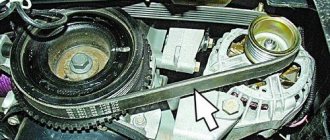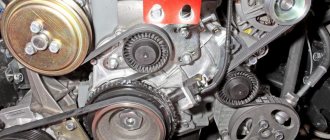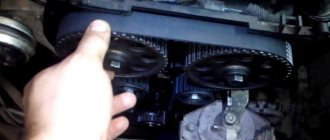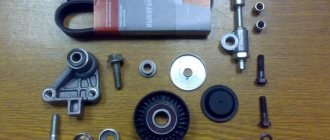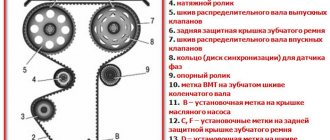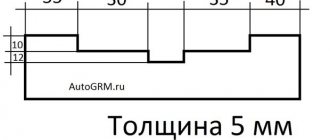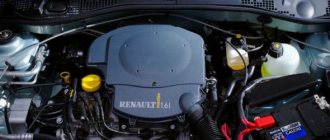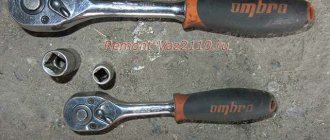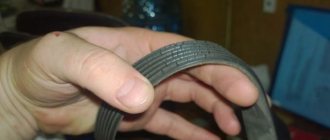Although on many cars the alternator belt is not as important an element as the timing belt, this element still needs to be checked and replaced regularly. The reason is that the generator drive belt allows both the car generator itself and other attachments (power steering, air conditioning compressor, etc.) to operate on cars.
Of course, if the belt breaks or there are any problems with the drive, the power steering, air conditioning, generator and other equipment will not work normally. Extraneous noises, squeaks, whistling of the generator belt, etc. also often appear.
Next, we will look at when to change the alternator belt, how to replace the drive belt, and what features you need to pay attention to as part of this procedure.
When and how to change the V-belt.
The main problem in a car when the drive belts wear out at the initial stage are various creaks and whistles that occur during the rotation of the pulleys transmitting torque to the engine attachments. If these creaks and whistles occur, one of the drive belts may simply break soon. Dear friends and our readers, we offer you detailed information about the types of belts installed in modern cars. Our information directory will help you find out when it is necessary to change drive belts and also how to determine the degree of their wear, how a drive belt differs from a timing belt and what is the average cost of drive belts on the Russian market, and at the same time get for yourself and answers to other questions that interest you directly related to these belts.
First, let's immediately dot the i's and find out what they are - drive belts.
A car drive belt is an element of a belt drive, a specific working part of vehicles and mechanisms that serves to transmit engine torque.
The transmission of torque occurs due to frictional forces or engagement forces (timing belts, V-belts).
There is a misconception that the timing belt (timing belt drive) is not a drive belt. Actually this is not true. The timing belt also falls into the category of drive belts.
Drive belts are divided into several types, namely:
— Timing belt (timing belt drive).
— Drive belts for auxiliary components (engine attachments).
There are 3 (three) types of car belts:
1. Timing belt - as a rule, it is toothed.
2. Poly V-belt transmitting engine torque to engine attachments.
3. V-shaped (V-belt) transmission of engine torque to engine attachments.
Belts No. 2 and No. 3 in our country also have additional names, that is: flat belt (V-ribbed belt) or ripple belt (V-belt).
Unlike timing belts, which are subject to fairly strict requirements, such as mandatory timely scheduled replacement in accordance with the service life established by the manufacturer, drive belts that ensure the operation of engine auxiliary (attachment) equipment do not require such close attention.
But, nevertheless, this does not mean at all that they do not need our attention. They also periodically require scheduled replacement. Moreover, it is not advisable to wait until the belts fail, since these belts ensure the operation of important equipment in the car (cooling, battery charging, air conditioning, etc.).
Thus, if you suddenly hear a squeak or whistle under the hood of your car, we advise you to pay attention to it. Remember that extraneous noise under the hood is not only a nuisance for your hearing, but also something more. If a creaking or whistling noise appears under the hood of the car, this indicates that the drive belt is slipping on the pulleys. For example, if the belt is old, then its tension may be significantly weakened, which causes the belt to slip on the pulleys and produce a squealing noise while the engine is running.
Typically, when a belt is worn out or has loose tension, the slipping or squealing will only worsen in rainy and cold weather as the belt loses its grip on the pulley due to moisture.
If you, friends, heard a single squeak or whistle of a belt under the hood of your car, especially after driving through a deep puddle, then there is no particular reason to worry. In this case, the drive belt is most likely too wet, which has reduced its adhesion specifically to the pulley. If you hear this whistle (squeal) under the hood after starting the car in the morning or after several kilometers, or after starting to drive, or when the engine warms up, then most likely your drive belts (or belt) are worn out or weakened the tension of these drive belts itself.
Adjustment roller
To make adjustments simple and quick, modern cars often use a special device - adjustment rollers. If we take the Lada Priora as an example, it is part of the design.
- When carrying out such work, it is worth using the key for seventeen. It will help you first unscrew the roller and then fix it again. Another tool is a roller wrench.
- It can be purchased for a small price at the nearest auto store. These are two rods attached to the base, four millimeters in diameter. Between them there remains a space of eighteen millimeters long. For some car owners, it is more convenient to use either curved pliers or a “platypus”.
- When making adjustments, the bolt is slightly unscrewed to secure it with a seventeen key. It holds a roller for adjustment. A special wrench will help turn the roller so that the belt tension either increases (in most cases) or decreases.
- Now it’s time again for the seventeen key, which will help fix the roller back for adjustment.
Even a driver without much experience will be able to do this procedure. Only the force must be selected correctly.
The check is performed as follows. After starting the engine, all consumers are turned on as much as possible. Their proper operation, as well as the absence of whistling, indicate that the belt was tensioned correctly.
Manufacturers of automobile vehicles recommend that a facelift should be carried out no less than after fifteen thousand kilometers. The belt will require replacement after sixty thousand kilometers.
Regardless of the adjustment method chosen to align the position of the generator belt, at the end of this procedure it is worth cranking the crankshaft an additional two or three times. This will help ensure that the belt tension remains the same.
In addition, it is worth driving around a little and checking again.
Function of the drive belt (V-V and poly V-belt)
A V-shaped or poly-V belt is part of the engine drive belts, which serves as an auxiliary component that ensures the functionality of the attachments of the car’s power unit (water pump, air conditioning, generator, hydraulic booster).
The belt rotates due to the torque of the engine during operation. Torque is initially transmitted by the crankshaft of the engine itself. Next, the torque is transmitted through belts and pulleys to auxiliary equipment located under the hood.
For example, a V-belt has a V-shaped cross section, which allows the belt to transmit torque to the vehicle accessory pulleys. This type of belt drive is called V-belt torque transmission.
For example, this type of belt is often used to transmit engine torque to an electric generator that charges the battery.
The rotation of the generator produces electricity, which supports the operation of all electrical equipment in the vehicle.
Also, in many modern cars, this type of belt is also used to transmit torque to the electric power steering, to the cooling fan, to the water pump (coolant pump), to the air conditioning compressor and to the classic power steering wheel. Since this belt is subjected to enormous loads and constant temperature changes, it is made, as a rule, of hard rubber and a metal core, which provides strength and durability to the belt. Also, many belts have a durable textile thread, which allows the belt to withstand the transmission of high torque.
So, friends, remember, each car, in addition to the timing belt (some cars also use a timing chain), has one or more belt drives (depending on the technical features of the car), which ensure the functionality of engine attachments.
Generator drive device
The main condition for the correct functioning of the generator is the correct transmission of rotation from the power plant. To generate the required amount of electricity, the element must rotate at high speed.
The alternator drive belt must be tensioned for proper transmission. If the belt sag, it will begin to slip on the pulleys. If the belt is overtightened, there is a risk of premature wear of the bearings, working surfaces of the pulley and belt.
To avoid these troubles, belt tension adjustment was included in the design.
In modern cars the number of attachments is large. This equipment is also driven by the crankshaft pulley, including the power steering pump and air conditioning compressor.
The drive of these two units and the generator is carried out using a single belt. Because of this, it is impossible to adjust the tension of the drive element using a generator. Such cars have a complex belt position configuration. Belt-driven equipment is located at different levels.
How to change the alternator belt tensioner pulley? To do this, you need to understand its structure. The generator belt tensioner roller is a bearing with a plastic lining on its outer race. The pad has a working surface along which the belt moves. There is a landing sleeve inside the roller. There are two types of rollers:
- Eccentric. The design of this video is quite simple. It contains only a bearing, a plastic lining and a bushing. A through hole passes through the bushing, offset away from the center of the roller. The roller is put on a pin through the hole, which is installed on the engine. To tighten, the roller must be rotated relative to the bolt.
- Roller with bracket. In this design, the roller is fixedly mounted on a bracket. The structure is attached to the power plant using bolts. Moving the bracket relative to the engine adjusts the tension. Manufacturers sometimes use rollers with a spring bracket. The spring allows you to independently adjust the tension.
The bearing is the main weak point of the roller. This part is forced to constantly experience loads. Wear of a part sometimes even ends in its complete breakdown.
It is recommended to change the bearing every time the belt is replaced.
If the drive belt is cracked.. (consequences)
If the drive belt (or belts) in your car are worn out, they will have cracks and abrasions on their surface. Eventually, while the car is moving, a whistle will begin to appear. In this case, it should be clear that the time has come for their planned replacement. Remember, friends, that if you do not change the drive belt on time, you risk being left without working car equipment. For example, if a belt has reached the end of its service life due to severe wear and tear, it will naturally break sooner or later.
Typically, when the drive belt breaks, you will hear a loud bang from under the hood. As a result, the equipment receiving torque from it will cease to function. For example, if the drive belt that powers the generator breaks, it will simply stop charging the battery and powering all the electrical equipment of the car. As a result, you will see the battery icon light up on the car dashboard.
Also, if the belt breaks, the power steering will stop working. As a result, your steering wheel will become very difficult to turn. But the most important problem when the drive belt breaks is the lack of rotation transmission to the water pump, which promotes the circulation of coolant through the engine cooling system. As a result, the engine can quickly overheat. In this case, you must immediately stop driving, stop and turn off the engine.
Therefore, friends, while driving, constantly monitor the engine temperature sensor, which should show the same temperature of 90 degrees after the engine warms up. If you notice that the temperature needle on the device has gone up and is approaching the dangerous red zone, then in this case you need to stop, turn off the engine and diagnose the cooling system.
Attention! Overheating of the engine can lead to its premature failure (damage to valve stem seals, head gaskets, and also damage to the piston system). Therefore, friends, do not under any circumstances allow the power unit to overheat; monitor the engine temperature on the dashboard.
Prerequisites for tension adjustment
Equipment manufacturers recommend checking the condition of the generator belt drive every 10-15 thousand kilometers. Mandatory replacement - after 60 thousand. The service life depends on the quality of the product materials and the driver’s accuracy.
A stretched belt slips in the grooves of the pulleys, which, as the load increases, is accompanied by a whistling rustle, clearly audible from under the hood.
The unstable operation of the generator is indicated by a control sensor signal that lights up on the dashboard in front of the eyes of the person driving. Often the cause of alarm is a failure due to a transmission belt stretched under load.
The deflection is determined by measuring in the middle of the longest free section between the parts being connected. If, when pressing a branch, the deviation from the original position exceeds 10-15 mm, the generator belt must be tensioned and the deviation brought to the recommended value.
Possible malfunctions in the electric generator drive and ways to eliminate them
Over time, the electric generator drive wears out and stretches. If consumables are not changed in time, the drive may break, which will lead to the car stopping. In this case, you need to install a new consumable and continue moving.
The procedure for replacing a torn product is simple: just loosen a couple of nuts and install a new part. The most difficult question is how to properly tension the alternator belt. If there is insufficient tension, it can slip, especially in high humidity, which leads to insufficient recharging of the battery.
The following symptoms of malfunction may appear:
- whistling in the area where the drive is located;
- voltage dips;
- dimmer headlights;
- flashing battery charging indicator on the dashboard.
If the tension is excessive, wear on the drive itself, the crankshaft bearings and the generating device increases, and this can also lead to breakage. In order to check the tension, you need to press the strap with a force of 10 kg. The tension will be optimal if it bends by 10-15 cm with the electric generator 37.3701 and by 6-10 cm with the electric generator 9402.3701.
What determines the service life of drive belts?
Modern drive belts have a fairly long service life, all thanks to their design and modern reliable materials. On average, a high-quality belt can last up to 25 thousand hours of operation. Please note that the service life is indicated in hours, and not in kilometers, since the mileage itself does not directly affect the service life of the drive belts. After all, these belts are in motion even when the car is standing still and the engine is idling.
But this is in theory and according to information provided by the belt manufacturers themselves to consumers.
In practice, the service life of drive belts may differ significantly from that declared by the manufacturer. The point is that the wear of drive belts is influenced by many different factors. For example, the way it was installed on the car plays an important role in the long service life of belts. For example, it is not uncommon for car mechanics in technical centers, due to their low qualifications or lack of experience in car repairs, to try to fit a belt onto a pulley using a screwdriver. Ultimately, the new belt will become damaged and will no longer last as long as the manufacturer claims. This method of installing a drive belt is also used when it is necessary to speed up the process of replacing it, so as not to remove the pulley.
In addition, the service life of belts is also affected by the storage conditions of these components in the warehouse and during their transportation. For example, it is not uncommon for car dealerships to sell drive belts that have expired. Yes, drive belts certainly have an expiration date. The point here is this: the chemical composition of the materials of drive belts changes over time, and if the drive belt was produced 5 years ago and was incorrectly stored in a warehouse, then when installed on a car it will naturally not last very long.
Weather can also affect the durability of belts in a car. For example, if you live in a region with a hot climate, then you often use air conditioning. This means that the air conditioning compressor must then receive more of the required energy. As a result, this belt, which transmits torque to the air conditioning compressor, begins to experience increased load.
In particular, drive belts can quickly wear out if the machine is operated for a long time in cold and damp weather. For example, in winter, the electrical equipment of a car requires more power than in warm and dry weather.
As a result, the alternator requires more energy to maintain the electrical system in the vehicle. Ultimately, the alternator belt begins to experience increased stress due to increased torque.
As a rule, these drive belts last longer in a new car because they were installed at the factory and all the necessary storage conditions were observed before they were installed. Once the factory drive belts are replaced, the service life of the newly installed belts will be reduced.
Each car manufacturer in the technical documentation and in the car service book usually indicates in routine maintenance the date when it is necessary to regularly replace the drive belts. Therefore, we advise you, friends, to carefully read the list of scheduled technical inspections and the regulations for replacing consumables. As a rule, the manufacturer indicates the maximum mileage at which the drive belts must be replaced at a car mechanic's technical center. Thus, you will approximately know for yourself the maximum service life of drive belts. But this does not mean that you should not regularly inspect the condition of the belts. More on this below.
Main problems with the alternator belt
Since the generator drive belt is flexible, the main problems with it are breakage, severe wear, delamination and sagging.
Belt breakage rarely occurs, since significant force is required for the reinforcing threads to break. It can only occur when one of the elements driven by the belt becomes jammed. For example, due to the destruction of a generator bearing, the rotor may jam, followed by a burst.
Severe wear occurs over time, because the surfaces of the belt rub against the surfaces of the pulleys when transmitting force. As a result, the belt profile decreases, it slips more and more, its transmission force drops and the generator stops producing the required energy.
Broken car alternator belt
Delamination is often caused by damage to the pulleys. Violation of the pulley geometry leads to the fact that on one side the belt wears out intensively, the reinforced thread extends beyond the edges of the rubber material, as a result, the belt is gradually divided into its component parts. Delamination can also occur due to poor quality materials.
Car alternator belt delamination
Subsidence also occurs over time due to wear and tear. As the belt wears out, its diameter increases, its tension weakens and slipping occurs. Also, subsidence can be caused by poor quality materials. The contact of fuels and lubricants on the surface of the belt often leads to a change in the physical parameters of the rubber, which can also cause it to sag.
The main sign of problems with the alternator drive belt is the appearance of third-party noise, in particular squeaks and high-pitched squeals. Squealing is usually caused by the belt slipping against the pulley, which is often caused by severe wear or sagging.
In a car where a tension roller is used for tensioning, the appearance of a squeal may indicate, in addition to belt wear, severe wear of the roller bearing.
A short squeal from the belt in winter indicates poor quality material. At subzero temperatures, such a belt significantly loses its elasticity, which leads to intense wear until it warms up. Such a belt will not last long.
Regularly checking drive belts
Periodically, every car owner should check the condition of all drive belts and their tension. To do this, check the belts with your finger while the engine is off. For example, by pressing your finger on the belt, you can understand for yourself whether the belt drive tension has loosened or not. Remember that the belt should not move during this inspection (move 1 - 2 cm). If you see something like this, then the cause is weak belt tension. You should also inspect the belt by touch for damage, and a visual inspection is also necessary for chips, cracks and torn elements on the belt.
To do this, use a flashlight, which will not only make your vision better, but can also help you identify worn areas on the belt (as a rule, worn areas of the belt will shine).
In any case, if you see damaged areas on the belt, then it must be replaced with a new one. Please note that when purchasing new drive belts you do not need to purchase original consumables. Today there are many non-original belts on the market, which are often even superior in quality to factory originals. For example, it has proven itself to be the largest supplier of drive belts.
The average cost of replacing a belt in a car repair shop is approximately 2,500 thousand rubles. The cost of car belts itself depends on the popularity of the brand and the cost of the product. There are both cheap drive belts on the market and expensive ones that have a special design and are able to withstand extreme loads.
Replacing the alternator belt on a Toyota Camry
Next, let's look at how replacement is carried out on a Toyota Camry. This car uses a poly V-belt. It is also used to drive a compressor and a liquid pump. A special tensioner is used to tighten this belt.
If you carry out the replacement according to all the rules, you will need to remove the right wheel, lining and engine crankcase protection to access the tensioner.
But some amateurs make the replacement without removing the wheel. To replace the belt itself, you do not need to unscrew anything, since the tensioner is equipped with a self-tensioning mechanism.
To remove the belt, use a 19mm wrench to hold the head located on the tensioner and turn it clockwise. This action releases the tension, after which the belt is removed from any pulley.
Before installing a new belt, you should look at the diagram of the position of the belt between the pulleys. To install it, first put it on all the pulleys, then press the tensioner and put the belt on its roller, after which the tensioner is released.
Not rated Loading.
Generator device, repair of generator VAZ 2110, VAZ 2111, VAZ 2112 with your own hands
How to tension, tighten or loosen a drive belt
If the cause of the whistle, squeal or squeak is actually a belt that has become loose and as a result slips on the pulleys, and if the belt does not have any signs of wear or damage, then to remove the extraneous sound you just need to tighten the belt.
Using the same example of a generator belt, this is done using a special adjusting bolt (on modern cars) or using an adjusting bar (on older cars).
For example, to tighten the alternator belt on a modern car, you need to do the following:
— Slightly loosen the generator mounting bolts (upper and lower fastenings).
— Turn the adjusting bolt clockwise, thereby moving the generator away from the engine block and immediately check the belt tension level.
— Then, tighten the nuts of the generator fastening elements.
Please note that in some vehicle systems, the process of tensioning the drive belts is too labor-intensive and requires the use of special tools.
Attention . New generation poly-V-ribbed elastic belts are currently widespread on the market, as well as in many cars. For example, one of the world's well-known manufacturers of such belts is currently. Their products have proven themselves to be the best today. This company is an official supplier for many car factories. Elastic poly V-belts do not require tensioning, tightening, etc. manipulation. Due to their design and material, such belts do not stretch. As a rule, such drive belts last a long time, approximately 120 thousand kilometers.
But for its (their) initial tension a special tool is needed.
In many cars, special belt tension rollers are also used for this, which saves drivers from constantly tightening these belts. The only drawback of this design, as a rule, is that when replacing drive belts, it is also necessary to change the tension roller itself, since its reuse together with a new belt is impossible.
Adjustment bar
This technique is used for old-style machines. The generator in this case is attached to the motor. A bolt with a nut and an arc-shaped strip will help with this.
The voltage level is adjusted when the bar, together with the generator, moves to the required distance relative to the motor.
Algorithm for performing actions:
- On the arc-shaped bar you need to unscrew the fastening nut;
- The generator moves in relation to the engine thanks to the help of a mount;
- Having decided on the new position of the generator, it must be secured again by tightening the nut.
If the first time it is not possible to establish the level of the required tension, it will not be difficult to repeat such a simple procedure.
Replacing drive belts at a technical center
Modern cars today are equipped with sophisticated technologies and new complex engines with additional equipment. Most modern vehicles have very, very little space under their hood. In some cars there is simply no free space under the hood. Therefore, replacing drive belts in new cars yourself is not so easy. After all, in order to replace drive belts, it is necessary to dismantle many attachments. And all this just to get to the belts themselves.
Typically, replacing drive belts along with rollers may take about 1.5 - 2 hours. The average cost of an hour in Russia is currently about 35 - 50 US dollars. Accordingly, the cost of replacing belts can range from approximately 2,500 to 9,000 thousand rubles (depending on the technical center, make and model of the car).
In older cars, the process of replacing drive belts usually lasts no more than half an hour, since due to the simpler design of the engine compartment, access to the rollers and belts is more convenient.
Adjustment bolt
For most modern automobile vehicles, a more progressive technique is used. In relation to the engine, in this case, the position of the generator can be changed using a special adjustment bolt.
Actions are carried out according to the following algorithm:
- The generator initially weakens both the lower and upper fastenings;
- Now you need to change the position of the generator using the adjustment bolt;
- The generator mount is fixed and then tightened.
By making adjustments in this case, you can safely equalize the level of belt tension.
How can I remove the whistling, squeaking or crackling sound coming from the belt under the hood?
Unfortunately for us, eliminating belt squeal by tightening does not always help. In this case, you need to replace the old belt with a new one. But many car owners prefer to delay this process itself for as long as possible. To do this, they purchase various sprays from auto stores that they spray on belts. As a result, to the surprise of many specialists and others, this helps.
But again, unfortunately, not for long. Some craftsmen even suggest using a screwdriver and a piece of soap to process the side surface of the belt while the engine is running. For our part, we categorically do not recommend doing this, since, on the one hand, it is very dangerous to carry out any work with rotating components while the engine is running, and on the other hand, the effect of such similar old-fashioned methods is short-lived.
Fixes
What to do if you hear a squeaking sound from the generator belt? You shouldn't change it right away. Sometimes there is a whistle, but the resource of the consumable has not yet been exhausted and it can be further used. Therefore, if extraneous sounds occur, you should inspect the belt drive and find out where the squeak comes from. To diagnose, open the hood and inspect the strap for:
- integrity of the part;
- degree of wear;
- presence of traces of working fluids on the surface;
- displacement of the pulley line, they must be strictly on the same line;
- degree of tension of the product.
Replacement should be done if the surface is worn out, there are cracks, assemblies, or frayed edges. If traces of oil, coolant or other contaminants are found, you can try cleaning the surface. Contamination prevents the product from stretching and moving evenly. If they cannot be removed, the consumable must be replaced.
Replacing consumablesThe cause of a whistling noise in the generator belt drive may be wear of the bearing in the tension roller or generator. To diagnose the serviceability of the tension roller, you need to dismantle it and check for defects and play. If any malfunctions are found, parts must be replaced.
The following factors influence the service life of components:
- terms of Use;
- driver's driving style;
- degree of load;
- product quality;
- correct installation.
The most common cause of whistling is poor belt tension. To check it, you need to press the product between the generator and crankshaft pulleys somewhere near the middle.
Checking product tension
The deflection should be in the range from 6 to 8 mm. If the tension is not correct, it needs to be adjusted. If the tension is poor, the unit does not produce a full charge. To tension you need to do the following:
- Open the car hood.
- Loosen the generator mounting nut.
Generator mounting nut
After this, the mechanism takes its original position, due to which the product weakens. In order to move the generator towards the engine compartment, you can use the pry bar as a lever.
Move the unit towards the engine compartment
By moving the device using the lever, we adjust the degree of belt tension. Check the tension by hand. If the strap is tensioned as required, fix the position of the generator by tightening the fastening nut. It’s also not worth over-tightening, as the bearings will wear out faster due to the heavy load.
After the tension adjustment procedure, you need to check the operation of the unit. Before starting the engine, you need to turn on several devices powered by the generator, for example, a heater, air conditioning, and high beams. If everything is in order, then there is no whistle and the charging level is at the proper level.
To improve the operation of the belt drive, you can lubricate both surfaces of the rubber product with special liquids, for example, Hi-Gear and VeryLube conditioners. With their help you can also get rid of squeaking, but they give temporary results. Regular use of conditioners extends the service life of belts by 1.5-2 times.
Air conditioner Hi-Gear
Thus, if you hear a whistle when starting the generator, you should not rush to a car service center. You can solve the problem yourself
It is important to correctly determine the cause of the whistling, and solutions are described in the article
V-shaped - V-belt, poly-V-belt and toothed belt - what is the difference?
The drive belts of engine attachments should not be confused with timing belts, which synchronize the operation of the valves in the cylinder head with the piston system of the engine block using the camshaft.
As a rule, the timing belt is made of a completely different material from the drive belts of the same generator and other auxiliary equipment. Also, in some cars, the water pump drive is driven not by the V-belt or poly-V belt itself, but specifically by the timing belt, which, due to the special design of the engine, in addition to powering the water pump, also synchronizes the operation of the valves with the pistons.
The timing belt is made from a plastic composite material and has many special teeth that protect the belt from slipping. This is necessary so that the valves work synchronously with the piston system itself and do not collide with each other. After all, many of us motorists already understand that if the timing belt slips and the timing of the gas distribution mechanism goes wrong, the engine will not be able to work or will simply fail.
The timing belt also tends to stretch and has a maximum service life. This belt requires closer attention from the motorist, since if it wears out or breaks, the car’s engine can be seriously damaged and damaged, which will ultimately lead to huge financial costs.
Read more about this here.
How long does the timing belt last on a VAZ 2112?
The timing belt on a VAZ-2112 should be changed every 50-60 thousand kilometers, and its general condition should be checked at least once every 3 months.
Interesting materials:
How to find likes on Facebook? How to find the ratio in which the bisector divides the side? How to find a dragon egg in a creative? How to find d in progression? How to find a VKontakte group? How to find all user comments on Instagram? How to find the height through a side? How to inflate wheels on a hoverboard? How to inflate a tire with a hand pump? How to inflate an air mattress with a pump?
Signs and symptoms
There are six main signs that the timing belt has jumped.
- The car engine is unstable.
- The engine constantly stalls.
- Noticeable loss of engine power and thrust.
- The engine starts with problems or does not start at all.
- The power plant is stuck.
- The sound of the engine becomes louder - a metallic knock appears.
Most often, it happens that the product jumps one tooth, and because of this, the engine continues to operate, but increases fuel consumption, and there are also interruptions in operation and starting.
If you suspect that several teeth have jumped, you should not restart the engine. In the worst case, this can cause the valves to bend.
Prerequisites for tension adjustment
Equipment manufacturers recommend checking the condition of the generator belt drive every 10-15 thousand kilometers. Mandatory replacement - after 60 thousand. The service life depends on the quality of the product materials and the driver’s accuracy. A stretched belt slips in the grooves of the pulleys, which, as the load increases, is accompanied by a whistling rustle, clearly audible from under the hood.
The unstable operation of the generator is indicated by a control sensor signal that lights up on the dashboard in front of the eyes of the person driving. Often the cause of alarm is a failure due to a transmission belt stretched under load.
The deflection is determined by measuring in the middle of the longest free section between the parts being connected. If, when pressing a branch, the deviation from the original position exceeds 10-15 mm, the generator belt must be tensioned and the deviation brought to the recommended value.
Symptoms of tensioner failure
Signs indicating malfunction or wear of the relevant parts:
- no battery charge indicator;
- a whistle or squeak in the area of the working area of the generator belt, appears when it slips in cases where the tension roller is jammed;
- a hum that sounds when a bearing wears out or fails;
- vibration of the belt or roller when the engine is running indicates wear of the bushing, replacement of which is inevitable;
- the amount of belt deflection exceeds one and a half centimeters, which indicates the need for appropriate adjustment;
- free play in the tension pulley or roller indicates that the bearing is worn out;
- one side of the belt is more stretched and worn, a sign of a bend in the tensioner bracket.
Work progress:
- It is necessary to loosen the nut of the lower mounting bolt of the generator and the tension nut (read here how to do this)
- Relax the belt tension.
- move the generator towards the engine and remove the belt from the generator pulley and the crankshaft pulley.
Installing a new belt We put the belt in place as follows: first we put the belt on the crankshaft pulley, and then on the generator pulley. After this, we adjust the belt tension and tighten the nuts of the generator mounting bolt and the tensioner nut.
Advice: I recommend that you always carry a spare belt with you in case of a break, since our manufacturers now know which ones, this can happen at the most unexpected moment.
In this article we will look at how to replace the coolant sensor on injection engines of VAZ 2110-2112 cars. So, for work we need a screwdriver with.
On VAZ 2110-2112 injector cars, an ignition switch (lock) of type 2110-3704005 is installed. The lock is equipped with an anti-theft locking device, as well as a blocking for re-activation of the starter when.
In this article we will look at how to check the generator on VAZ 2110-2112 cars. So, for work we will need: Maltimeter; Technical stethoscope; Assistant. Work progress: First.
2017. Russia - VAZ 2110-12. All about operation and repair. Copying materials is prohibited. Using materials without providing a backlink to the source is prohibited.
CHANGING THE GENERATOR BELT
Surely, if you are looking for tips on how to remove the alternator belt and then put it back in place, you have already encountered the problem of its malfunction. Know that in order to perform the replacement correctly, you do not need to contact a car service; you can completely perform this procedure yourself. So, first we need to decide what tools we need to replace the alternator belt:
- Socket wrenches for 17 and 19, you can also use open-end wrenches;
- 10mm socket;
- Special tension wrench;
- Flat screwdriver;
- Ratchet wrench.
Further work must be performed according to the following instructions:
Replacement instructions
How to replace the alternator belt with your own hands?
Let's look at the process using the VAZ 2108 as an example:
- First, the strap is dismantled. To remove the RG, you will need to loosen the fixing nuts at the bottom and on the tensioner itself. During loosening, the generator itself should be moved towards the motor, after which the loosened strap is simply removed from the shafts.
- How to install the alternator belt? In this case, there is nothing complicated - the process of installing the belt is carried out according to the same scheme. The strap is installed on the pulleys, after which the generator is simply moved away from the power unit using a pry bar.
- The tension should be maintained using a crowbar, while the nut on the tensioner should be tightened. Next, you need to tighten the nut and check the installation process. If after replacement there are no extraneous sounds when starting the engine, then the procedure was carried out correctly. If there is a whistle, tighten the strap.
